You’ll master mixed metal jewelry design by starting with compatible pairings like silver-white gold or yellow-rose gold combinations. Apply the rule of thirds when layering, using one statement piece with two complementary accents at varying lengths. Create visual hierarchy by establishing a dominant metal foundation with strategic accent pieces. Mix textures and finishes for depth, distribute pieces evenly across your body, and incorporate bridging elements for seamless shifts. These foundational techniques will reveal advanced styling secrets.
Understanding Metal Compatibility and Natural Pairings

When you’re starting your mixed metal jewelry journey, understanding which metals naturally complement each other will save you from design missteps and create more polished results.
Metal compatibility isn’t arbitrary—certain natural pairings create stunning visual harmony in your jewelry collection.
Silver and white gold form the foundation for sleek, contemporary jewelry styling that works beautifully in layered designs. Their cool tones create sophisticated combinations without competing for attention.
Cool-toned silver and white gold create effortless sophistication in layered jewelry without visual competition.
Conversely, yellow gold and rose gold bring warm richness through their complementary nature, adding depth to any ensemble.
For a seamless mixed metals approach, copper and silver enhance each other effortlessly when combined in single pieces.
Start with two compatible metals to maintain balance, then gradually expand your combinations as you develop confidence in creating harmonious gold and silver designs.
Mastering the Rule of Thirds for Balanced Layering
Building on your mastery of metal compatibility, the Rule of Thirds becomes your blueprint for creating balanced, visually appealing jewelry layers. When layering necklaces with mixed metals, you’ll establish one statement piece as your focal point, then add two complementary jewelry pieces at varying lengths. This technique creates depth and visual interest while maintaining balance across your entire look.
| Layer Position | Purpose | Mixed Metal Example |
|---|---|---|
| Short/Choker | Accent piece | Rose gold chain |
| Medium | Focal point | Silver statement pendant |
| Long | Foundation | Gold layering chain |
| Wrist Stack | Statement piece | Copper cuff bracelet |
| Wrist Accent | Supporting layers | Thin silver + gold bands |
Apply this Rule of Thirds methodology across all jewelry regions—neck, wrists, and fingers—ensuring your mixed metals create a cohesive, proportioned appearance throughout.
Creating Visual Hierarchy With Dominant and Accent Metals
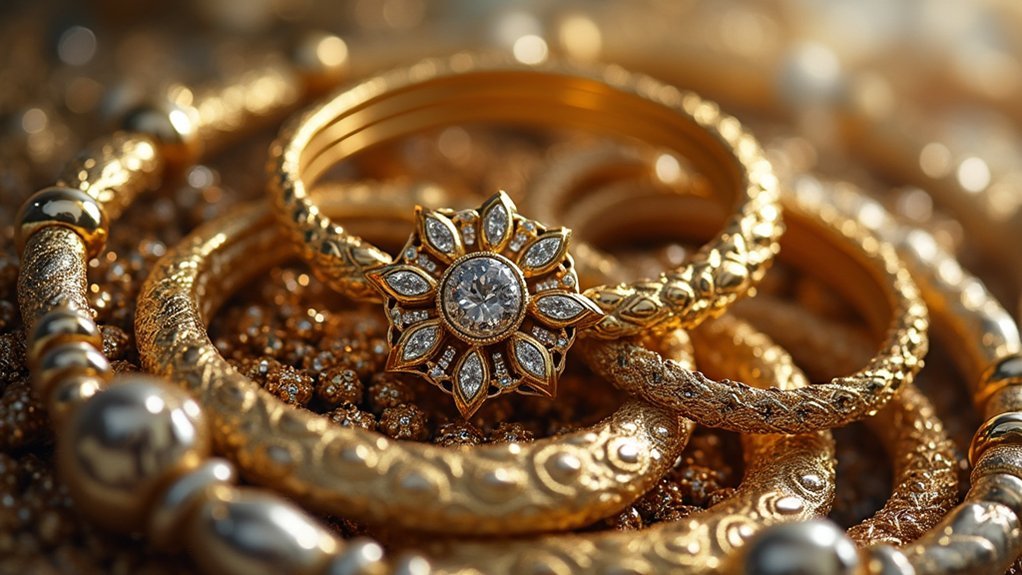
Three fundamental principles guide successful mixed metal jewelry arrangements: establishing dominance, creating contrast, and maintaining balance.
Start by selecting your dominant metal—whether yellow gold or silver—as your foundation piece that’ll anchor your entire look. This should be your most prominent jewelry piece, drawing immediate attention.
Your dominant metal serves as the visual anchor that ties your entire jewelry look together and commands attention.
Next, choose accent metals that create cohesive contrast with your base. Rose gold beautifully complements yellow gold, while white gold pairs excellently with silver.
Use strategic layering techniques to position your dominant metal centrally, with accent metals surrounding it for visual hierarchy.
Scale matters greatly in mixed metal jewelry design. Bolder, thicker pieces work best as dominant elements, while delicate, thin pieces serve as perfect accents.
Limit yourself to one or two accent metals alongside your dominant choice for a polished appearance.
Texture and Finish Combinations for Added Depth
Surface textures transform mixed metal jewelry from simple combinations into sophisticated, multi-dimensional statements.
You’ll create visual interest by incorporating varied finishes like polished, matte, and hammered surfaces that make each metal stand out distinctly. When layering pieces, contrast smooth against rough textures to enhance the natural differences between your mixed metals.
Strategic finish combinations catch light differently, adding depth and aesthetic appeal to your overall look.
Try pairing a matte gold necklace with polished silver earrings for balanced complexity.
Don’t overlook intricate detailing like filigree or engraving, which provides additional texture layers that harmonize beautifully with smoother elements.
These thoughtful combinations prevent your mixed metal ensemble from appearing flat while maintaining sophisticated elegance.
Strategic Placement Across Jewelry Regions

Once you’ve mastered texture combinations, strategic placement becomes your roadmap for creating balanced mixed metal looks that flow seamlessly across your body.
Focus your layering efforts within single regions – stack multiple necklaces of different lengths around your neck or layer bracelets on one wrist. This approach prevents visual chaos while maximizing impact.
Keep your layering concentrated in one area rather than scattered across multiple zones for maximum visual impact without overwhelming chaos.
When combining gold and silver pieces, verify your metal tones echo across regions. If you’re wearing mixed metal necklaces, coordinate your rings and earrings accordingly.
Limit heavy layering to one focal area while keeping other zones minimal – this creates a polished, intentional appearance.
Consider how your strategic placement complements your outfit’s neckline and silhouette. The right positioning transforms individual mixed pieces into one cohesive, stylish look that appears effortlessly curated.
Incorporating Bridging Elements and Transitional Pieces
You’ll find that mixed metal bridgers act as the perfect connective tissue between contrasting jewelry pieces, creating visual harmony throughout your ensemble.
These versatile elements include rings, necklaces, or bracelets that intentionally combine multiple metals within a single design.
Transitional items work similarly by featuring graduated color shifts or intertwined metals that ease the eye’s movement between your gold and silver accessories.
Mixed Metal Bridgers
When you’re working to harmonize different metal tones in your jewelry collection, bridging pieces serve as the essential connectors that make mixed metal styling feel intentional rather than accidental.
These connecting pieces create visual flow between various metals, allowing you to build a diverse metal ensemble with confidence.
Consider incorporating these mixed metal bridgers:
- Two-tone rings combining yellow and white gold for seamless integration
- Necklaces featuring both silver and gold chains for smooth connections
- Mixed metal bracelets with unified designs as foundational elements
- A two-tone watch that simplifies mixing while enhances versatility
These bridging pieces eliminate the guesswork from layering different metals.
They’ll transform your jewelry combinations from potentially clashing elements into sophisticated, cohesive looks that showcase intricate details.
Transitional Design Elements
Building on the foundation of mixed metal bridgers, specific design elements within individual pieces can elevate your styling approach beyond simple connecting strategies.
Transitional design elements in jewelry create seamless flow between contrasting metals like rose gold and silver. You’ll find two-tone bracelets and earrings work as versatile connectors, unifying various metal tones while maintaining a cohesive look. These pieces enhance visual interest and simplify the mixing process considerably.
When selecting transitional designs, focus on items with similar themes and textures to create harmony across your collection.
Iconic mixed metal pieces from renowned designers often feature thoughtful transitions that boost adaptability. These sophisticated elements transform individual jewelry pieces into powerful styling tools that effortlessly bridge different metals throughout your ensemble.
Proportional Scaling for Cohesive Mixed Metal Stacks
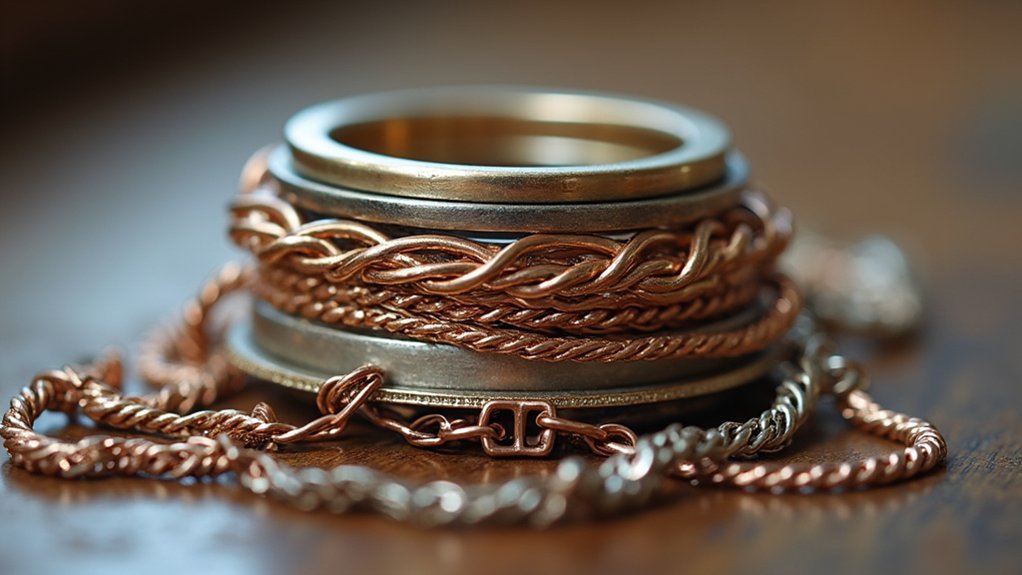
Since mixed metal jewelry creates visual complexity, proportional scaling becomes essential for achieving a balanced, cohesive appearance that doesn’t overwhelm your overall style.
When stacking metals, you’ll want to vary sizes and thicknesses strategically to create visual harmony across your entire look.
Master proportional scaling with these key techniques:
- Ring layering: Mix thin and thick bands using a 1:2 or 1:3 ratio—pair one thicker piece with two or three thinner ones for ideal balance
- Necklace cascading: Use different lengths to create separation while maintaining cohesion through your layered mixed metals
- Body distribution: Distribute evenly across your body by pairing chunky bracelets with delicate earrings
- Dimensional balance: Vary proportions to enhance interest without letting any single piece dominate your overall aesthetic
Frequently Asked Questions
How to Properly Mix Metal Jewelry?
Choose one dominant metal as your anchor, then add complementary pieces gradually. You’ll want to balance metals across your body and consider your skin’s undertones when selecting combinations for cohesive styling.
How Do You Mix Metals Successfully?
You’ll mix metals successfully by choosing one dominant metal as your base, then adding complementary accents. Start with simple two-metal combinations, layer different lengths, and consider your skin’s undertones for flattering results.
What Is the Rule for Mixing Metals?
Choose one dominant metal as your focal point, then add complementary secondary metals sparingly. Distribute pieces evenly across your outfit, limit yourself to two or three metal types, and consider your skin’s undertones.
Are Mixed Metals Still in Style?
You’ll be happy to know mixed metals are absolutely still in style for 2023. They’re trending on runways and with celebrities, offering you versatility and sophistication while expressing your unique personal style.
In Summary
You’ve now got seven powerful techniques to elevate your mixed metal jewelry game. Don’t be afraid to experiment with different combinations—start with one or two methods and gradually build your confidence. Remember, there’s no single “right” way to mix metals. Trust your instincts, pay attention to proportions, and let your personal style guide your choices. With practice, you’ll create stunning, cohesive looks that showcase your unique aesthetic.


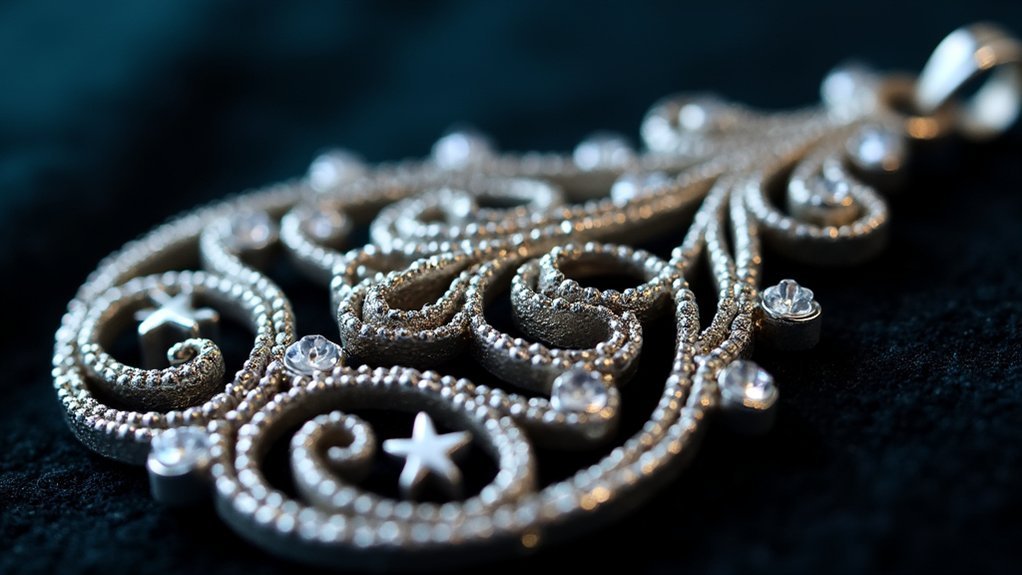
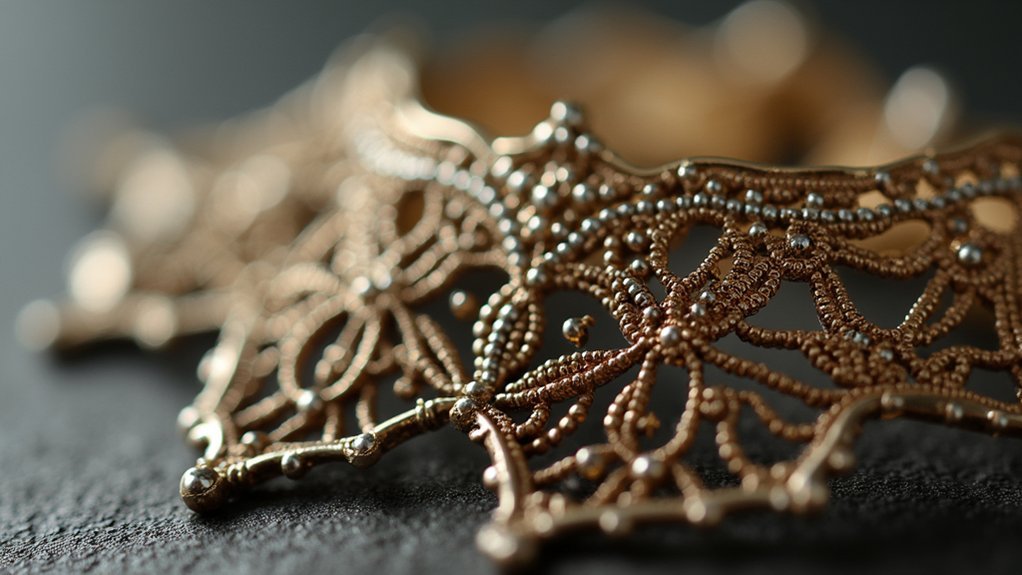
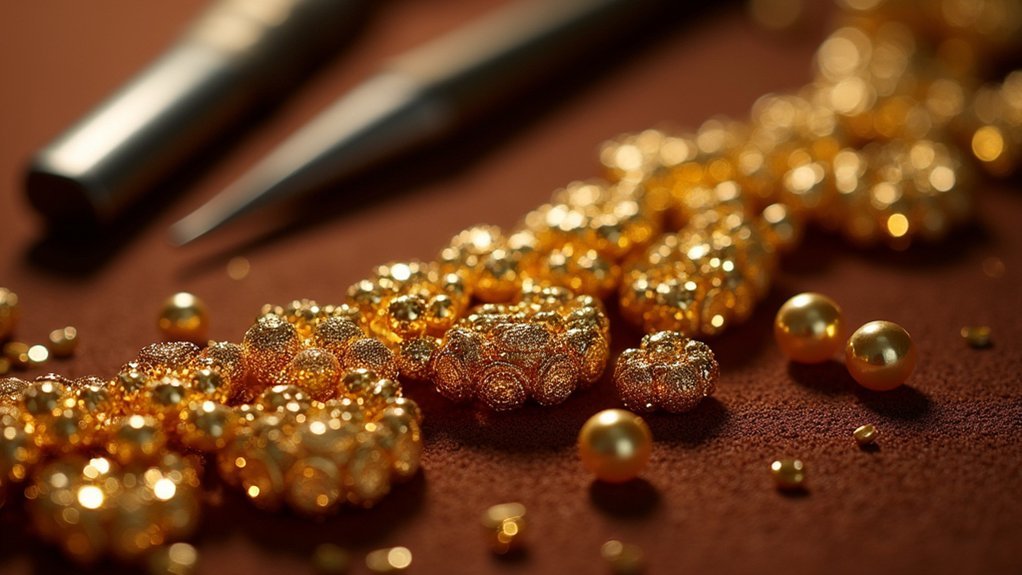
Leave a Reply